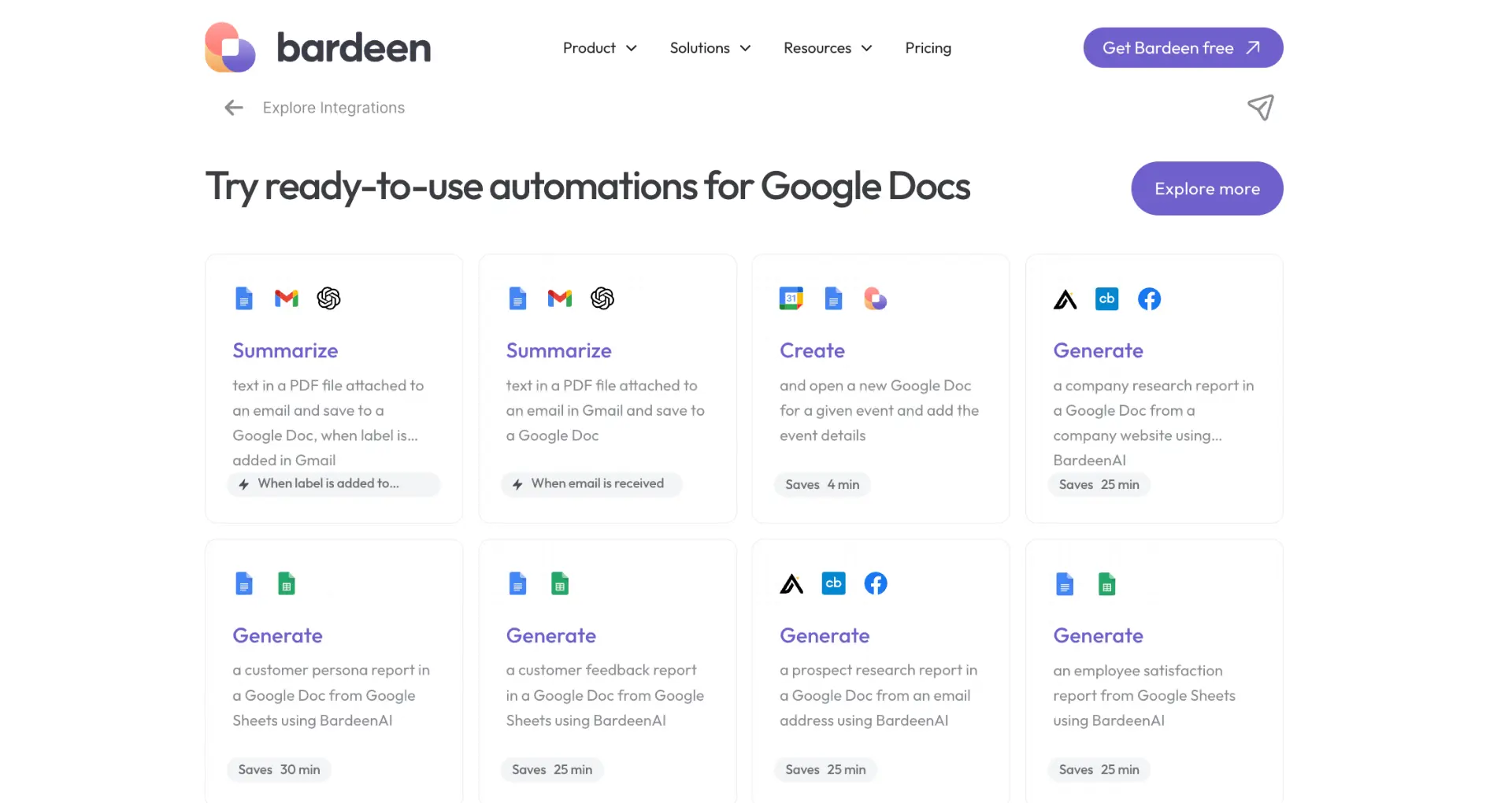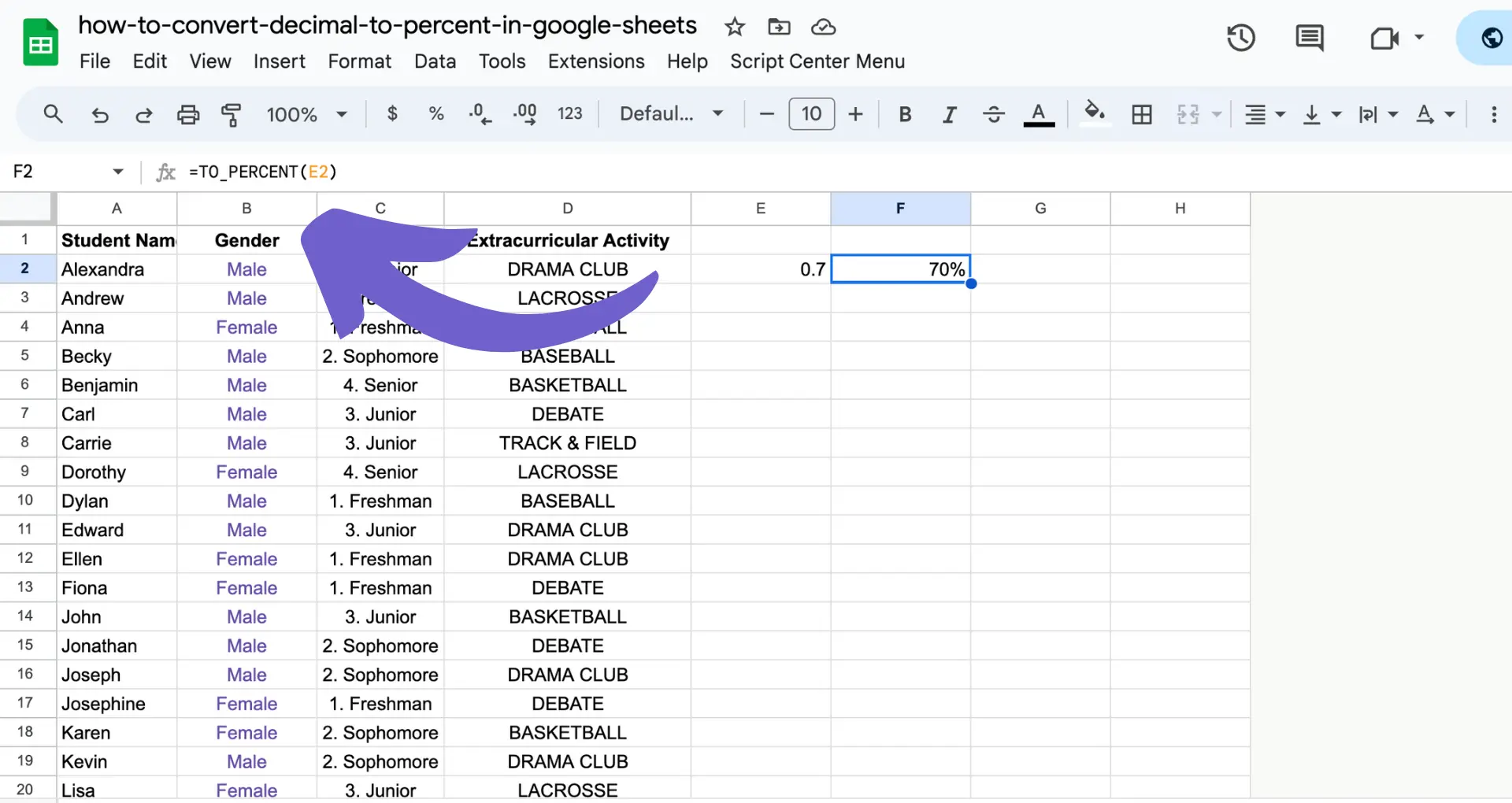





Use the TEXT function to convert time to text in Google Sheets.
By the way, we're Bardeen, we build a free AI Agent for doing repetitive tasks.
If you're working with time data, check out our GPT in Spreadsheets. It helps you format and convert time data effortlessly.
Converting time to plain text in Google Sheets is a crucial skill for efficiently managing and analyzing time-based data. In this step-by-step guide, we'll walk you through the process of using built-in functions and custom formatting options to transform time values into readable text formats. By mastering these techniques, you'll be able to create more user-friendly and intuitive spreadsheets that effectively communicate time information.
Working with time data in Google Sheets can be tricky, especially when you need to convert it to a plain text format for reporting or integration with other systems. Whether you're tracking employee hours, analyzing website traffic patterns, or managing project timelines, being able to effectively manipulate and display time information is essential. In this step-by-step guide, we'll explore powerful functions and techniques that will enable you to:
By the end of this guide, you'll have a comprehensive understanding of how to convert time to plain text in Google Sheets, empowering you to create more streamlined and user-friendly spreadsheets that drive productivity and insights. For more advanced features, consider using GPT in Spreadsheets to bring AI into your workflow.
The TIMEVALUE function in Google Sheets plays a crucial role in converting time strings into a decimal format, representing a fraction of a 24-hour day. This conversion enables users to perform calculations and data manipulations that would otherwise be challenging with time values in a text format.
To use the TIMEVALUE function, simply provide a time string within quotation marks as the argument. For example:
TIMEVALUE("2:15 PM")TIMEVALUE("14:15:30")TIMEVALUE("11:59:59.50 PM")The function accepts time strings in both 12-hour and 24-hour formats, with or without seconds. It returns a decimal value between 0 (inclusive) and 1 (exclusive), where 0 represents 12:00:00 AM and 0.9999884259 corresponds to 11:59:59 PM.
By converting time values to decimals, users can easily:
Understanding the TIMEVALUE function is essential for anyone working with time-based data in Google Sheets, as it unlocks a wide range of possibilities for data analysis and visualization. For more advanced uses, you might want to connect Google Sheets with other tools.
Bardeen can help you automate data enrichment tasks in Google Sheets, saving you time and effort.
The TEXT function in Google Sheets is a powerful tool for converting time values into custom text formats. This function allows you to display time data in a more readable and user-friendly manner, making it easier to work with and interpret.
The syntax for the TEXT function is as follows:
=TEXT(value, "format_text")

Here, value represents the time value or cell reference you want to format, and "format_text" is a string that specifies the desired format for the output.
For example, to convert a time value in cell A1 to the format "hh:mm AM/PM", you would use the following formula:
=TEXT(A1, "hh:mm AM/PM")
This would display a time like "14:30" as "02:30 PM".
Some common time formatting codes include:
"h:mm" - Hours and minutes (12-hour clock)"hh:mm" - Hours and minutes with leading zero (12-hour clock)"h:mm AM/PM" - Hours and minutes with AM/PM (12-hour clock)"H:mm" - Hours and minutes (24-hour clock)"HH:mm" - Hours and minutes with leading zero (24-hour clock)"m:ss" - Minutes and secondsBy combining these formatting codes, you can create custom time formats that suit your specific needs. For instance:
=TEXT(A1, "hh:mm:ss AM/PM")
This would display a time like "14:30:45" as "02:30:45 PM".
The TEXT function is particularly useful when you need to concatenate time values with other text or when you want to apply conditional formatting based on time thresholds. It provides a flexible way to manipulate and display time data in Google Sheets. For more advanced uses, consider adding AI to Google Sheets to further enhance your workflow.
Google Sheets provides a range of options for custom formatting of time data, allowing you to display hours, minutes, and seconds in a format that best suits your needs. Here's how to access and use these custom formatting options:
When creating a custom time format, you can use the following codes:
h - Hours (1-12)hh - Hours with leading zero (01-12)H - Hours (0-23)HH - Hours with leading zero (00-23)m - Minutes (0-59)mm - Minutes with leading zero (00-59)s - Seconds (0-59)ss - Seconds with leading zero (00-59)AM/PM - Uppercase AM/PMam/pm - Lowercase AM/PMFor example, to display time as "09:30:00 AM", you would enter the following custom format:
hh:mm:ss AM/PM
Once you have created your desired custom time format, click "Apply" to apply the formatting to the selected cells.
By taking advantage of these custom formatting options, you can ensure that your time data is displayed in a clear and consistent manner throughout your spreadsheet. This can be particularly useful when working with large datasets or when collaborating with others who may have different formatting preferences. Use these tips alongside GPT in Spreadsheets to streamline your workflow even more.
Save time by automating repetitive tasks in Sheets. Check out how you can connect Microsoft Excel and streamline your workflow.

When working with time data in Google Sheets, there are a few common errors that users may encounter. One of the most typical issues is entering an incorrect time string format within a function like TIMEVALUE or TEXT. For example, using "2:15" instead of "2:15 PM" can lead to unexpected results or errors.
To troubleshoot this issue, ensure that your time strings are properly formatted and enclosed in quotation marks. Google Sheets expects time strings in a specific format, such as "HH:MM AM/PM" or "HH:MM:SS". Double-check your input and make sure it matches the required format.
Another common pitfall is forgetting to use quotation marks around the time string within the function. For instance, writing =TIMEVALUE(2:15 PM) instead of =TIMEVALUE("2:15 PM") will result in an error. Always remember to enclose your time strings in quotation marks to avoid such issues.
If you encounter an error like "#VALUE!" in your spreadsheet, it typically indicates that Google Sheets cannot recognize the time string format you've provided. Carefully review your input and ensure it follows the correct syntax and formatting requirements.
By being mindful of these common pitfalls and double-checking your time string formats and syntax, you can prevent errors and ensure accurate time conversions in your Google Sheets spreadsheets. Additionally, you may want to learn how to extract phone numbers from LinkedIn for your data collection needs.
Google Sheets offers powerful functions that can be combined to handle dynamic time data conversions. By leveraging functions like TIMEVALUE, TEXT, and NOW(), you can create formulas that automatically convert time values based on the current time or specific time zones.
One common use case is converting the current time to a text string for timestamping in logs or reports. To achieve this, you can combine the NOW() function with the TEXT function. The NOW() function returns the current date and time, while the TEXT function allows you to format the output as desired. For enhanced automation, you might consider using a LinkedIn profile scraper to streamline your workflow.
Here's an example formula that converts the current time to a text string:
=TEXT(NOW(), "yyyy-MM-dd hh:mm:ss")

This formula uses the NOW() function to get the current date and time, and then passes it to the TEXT function. The second argument of the TEXT function specifies the desired format for the output string. In this case, it will display the date in the "yyyy-MM-dd" format and the time in the "hh:mm:ss" format.
You can further customize the format by modifying the second argument of the TEXT function. For example, to include the time zone abbreviation, you can use:
=TEXT(NOW(), "yyyy-MM-dd hh:mm:ss 'PST'")
This will append the "PST" time zone abbreviation to the output string.
Another powerful combination is using the TIMEVALUE function with the TEXT function to convert time values between different time zones. The TIMEVALUE function converts a time string to a decimal value representing the time, while the TEXT function can be used to format the output in the desired time zone.
Here's an example formula that converts a time value from one time zone to another:
=TEXT(TIMEVALUE("2023-06-01 10:00:00") + TIME(3,0,0), "yyyy-MM-dd hh:mm:ss")
In this formula, the TIMEVALUE function converts the time string "2023-06-01 10:00:00" to a decimal value. The TIME function is then used to add 3 hours to the time value, effectively converting it to a different time zone. Finally, the TEXT function formats the result back into a string representation.
Save time by using Bardeen to connect Google Docs with Google Sheets. Automate tasks and spend less time switching between apps.

By combining these functions and adjusting the time zone offset, you can dynamically convert time values between different time zones based on your specific requirements. For more advanced techniques, you can also scrape data from websites to enhance your data handling capabilities.
Remember to carefully consider the input formats and desired output formats when working with dynamic time data conversions. Experiment with different combinations of functions and formatting options to achieve the desired results for your specific use case.
When working with time data in Google Sheets, it's crucial to maintain accuracy and clarity, especially when dealing with multiple time zones. Here are some best practices to keep in mind:
In addition to these practices, it's important to consider data formatting for seamless integration with other tools. When exporting or importing time data between Google Sheets and other data analysis or visualization tools, consistent formatting is key. Some tips include:
By following these best practices and considering data formatting requirements, you can effectively manage time data in Google Sheets and ensure smooth integration with other data analysis and reporting tools.









SOC 2 Type II, GDPR and CASA Tier 2 and 3 certified — so you can automate with confidence at any scale.
Bardeen is an automation and workflow platform designed to help GTM teams eliminate manual tasks and streamline processes. It connects and integrates with your favorite tools, enabling you to automate repetitive workflows, manage data across systems, and enhance collaboration.
Bardeen acts as a bridge to enhance and automate workflows. It can reduce your reliance on tools focused on data entry and CRM updating, lead generation and outreach, reporting and analytics, and communication and follow-ups.
Bardeen is ideal for GTM teams across various roles including Sales (SDRs, AEs), Customer Success (CSMs), Revenue Operations, Sales Engineering, and Sales Leadership.
Bardeen integrates broadly with CRMs, communication platforms, lead generation tools, project and task management tools, and customer success tools. These integrations connect workflows and ensure data flows smoothly across systems.
Bardeen supports a wide variety of use cases across different teams, such as:
Sales: Automating lead discovery, enrichment and outreach sequences. Tracking account activity and nurturing target accounts.
Customer Success: Preparing for customer meetings, analyzing engagement metrics, and managing renewals.
Revenue Operations: Monitoring lead status, ensuring data accuracy, and generating detailed activity summaries.
Sales Leadership: Creating competitive analysis reports, monitoring pipeline health, and generating daily/weekly team performance summaries.
